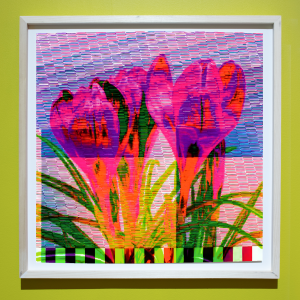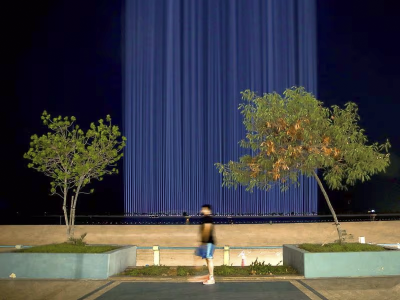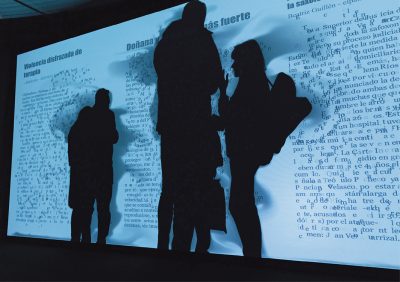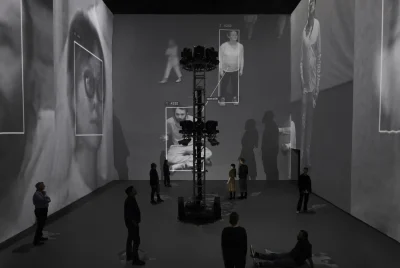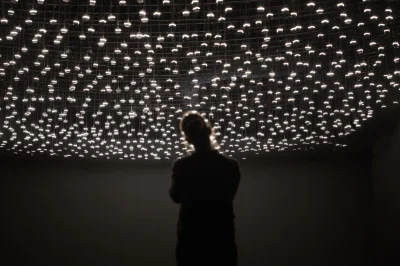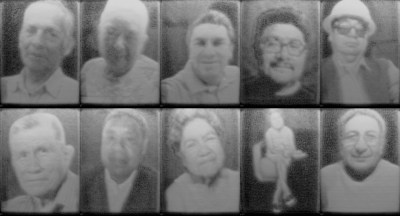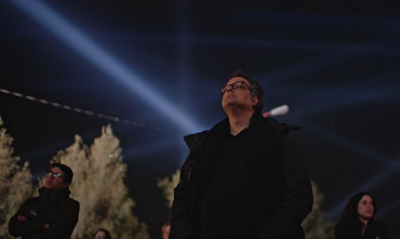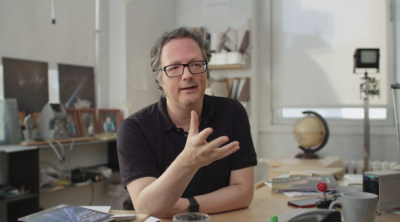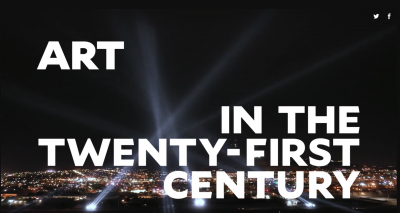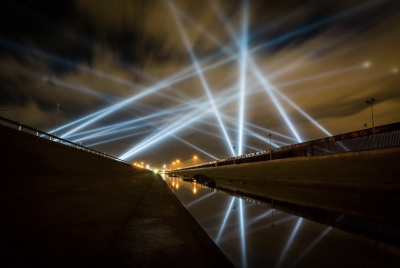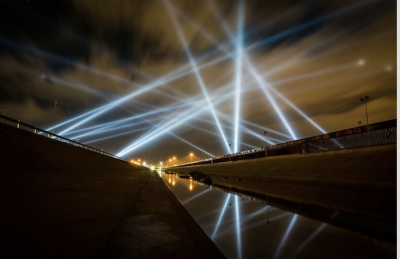Internationally renowned for his monumental public art installations, Mexican-Canadian new media artist debuts more intimate interactive work in a second United States solo show.
RAFAEL LOZANO-HEMMER
September 15-October 21, 2006
Internationally renowned for his monumental public art installations, Mexican-Canadian new media artist debuts more intimate interactive work in a second United States solo show
“[Lozano-Hemmer’s] work may in fact be a perfect opportunity for us to visualize technology…but also actively join in creating an artistic expression of science’s modern advances. We can even control it for once.”—International Herald Tribune
August 2006, New York, NY—bitforms gallery is pleased to announce the second, U.S. solo exhibition of Rafael Lozano-Hemmer—the Mexican-Canadian, new media artist who has achieved international prominence for his monumental, interactive public art “interventions.” At the crossroads of architecture and theater, Lozano-Hemmer’s work has been praised for redefining the meaning of “interactivity,” using perverse technologies of surveillance to engage participants in an active, critical way. The upcoming bitforms gallery exhibition will feature the more intimate installations recently developed by the artist and reflecting his preoccupations with computer vision, portraiture and phantasmagoria. On view will be, among others, the premiere of Close Up and Third Person (2006), the latest creations of Lozano-Hemmer’s new series, “Shadow Box”, and Standards and Double Standards (2004), hailed by Beaux Arts Magazine in Paris as “Best of the Art Basel Fair”.
The recipient of three awards from Ars Electronica, including a Golden Nica, Lozano-Hemmer is the mastermind behind Vectorial Elevation (1999), commissioned for Mexico City’s celebration of the Millennium and considered the world’s largest interactive installation; Body Movies (2001), presented in five European cities and to be staged again in Hong Kong next November; and the most recent Under Scan (2006), which transformed pedestrian areas in the East Midlands region of the U. K. into huge shadow playgrounds. In addition, Lozano-Hemmer’s artworks were recently acquired by prestigious contemporary art collections such as the Daros Foundation in Zürich, the Jumex collection in Mexico, the Cisneros Fontanals Foundation in Miami and The Museum of Modern Art in New York City.
Lozano-Hemmer’s work taps into the technology of data-networks, robotics, sensors, cell phones, projections and other custom-made devices to create “connective, participatory experiences,” in which several realities co-exist. Playful, yet always provocative, his installations have been praised for creating platforms for group experience rather than individual interfaces for solitary participation.
Shown for the first time, Close up and Third Person are part of the “Shadow Box” series that builds up on Lozano-Hemmer’s concepts developed in Under Scan, and in which passers-by activate portraits in their own shadows. Close up creates the viewer’s image with hundreds of tiny videos of other people who have recently looked at the work. When a viewer approaches, the system automatically makes a video. Up to 800 recent recordings are simultaneously triggered inside the viewer’s silhouette, suggesting a schizoid experience where people’s image sets off a massive array of surveillance videos. In Third Person, the interactive display draws the viewer’s portrait in real time with hundreds of tiny words, which are all the English, Spanish, and English verbs conjugated in the third person. In addition to these two pieces, the exhibition will include “Under Scan Portraits” Lambda print, video and book of signatures of the 800 people who participated in the Under Scan public art installation.
Originally shown at the 2004 Art Basel and receiving its U.S. premiere at bitforms, Standards and Double Standards turns the body into a target of predatory, electronic surveillance. A dozen buckled belts—fetishes of paternal authority—hang at waist height from stepper motors on the ceiling. Controlled by a computerized tracking system, the belts automatically rotate to follow visitors, slowly turning their buckles to face them. When several people enter the room, their presence affects the entire group of belts, creating chaotic patterns of interference. Development of Standards and Double Standards was funded by a Rockefeller Fellowship and a grant from the Daniel Langlois Foundation.
“Lozano-Hemmer’s work requires us to reassess our notions of the analog and the digital, of language and code, meaning and force, human and nonhuman communication,” writes Brian Massumi in Artforum Magazine. “But it does so not by commenting, critiquing, or sending a message itself. It does it aesthetically, by which I do not mean “beautifully” (although his installations always are that, too). Rather, I mean “aesthetic” in something closer to the etymological meaning: as in aesthesis, “making sensible.”
For more information visit: www.bitforms.com and www.lozano-hemmer.com
Biography:
Rafael Lozano-Hemmer’s interactive installations have been commissioned for events such as the Millennium Celebrations in Mexico City (1999), the Cultural Capital of Europe in Rotterdam (2001), the United Nations’ World Summit of Cities in Lyon (2003), the opening of the Yamaguchi Centre for Art and Media in Japan (2003) and the Expansion of the European Union in Dublin (2004). His work in kinetic sculptures, responsive environments, video installation and photography has been shown in two dozen countries, including the Sydney Biennale (Australia), Art Basel Unlimited (Switzerland), the Liverpool Biennial (UK), the Shanghai Biennial (China), the Itau Cultural (Brazil), the Istanbul Biennial (Turkey), ARCO art fair (Spain) and others. He is the recipient of several Ars Electronica Awards (a Golden Nica, a Distinction and two honorable mentions), two BAFTA British Academy Awards for Interactive Art in London, a “Design Review Gold Award” given by I.D. Magazine, and an International Bauhaus award in Germany, among many others. Born in 1967 in Mexico City, Rafael Lozano-Hemmer received a B. Sc in Physical Chemistry from Concordia University in Montreal, Canada, where he resides.

